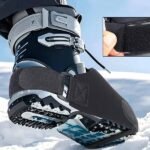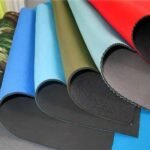Have you ever wondered which type of glove is best suited for your specific needs: nitrile or neoprene? Choosing the right glove can significantly impact your comfort, protection, and efficiency in various tasks. As someone who has extensively used both nitrile and neoprene gloves in different environments, I understand the importance of making an informed decision to ensure safety and performance.
Understanding the differences between nitrile and neoprene gloves is essential for selecting the right protection for your hands, tailored to your specific tasks and environments.
I recall a project where I needed gloves that could handle both chemical exposure and provide flexibility for intricate work. Initially, I reached for nitrile gloves due to their chemical resistance, but I soon realized that neoprene gloves offered the additional flexibility I required without compromising on protection. This experience highlighted the nuanced differences between the two types of gloves.
What Are Nitrile and Neoprene Gloves?
Nitrile and neoprene gloves are two popular types of disposable gloves used across various industries for protection against chemicals, punctures, and other hazards. Nitrile gloves are made from synthetic rubber, offering excellent resistance to oils, solvents, and a wide range of chemicals. Neoprene gloves, on the other hand, are also made from synthetic rubber but provide superior flexibility and resistance to a different set of chemicals and environmental conditions.
Nitrile gloves are renowned for their chemical resistance and durability, while neoprene gloves excel in flexibility and comfort, making each suitable for different applications.
During my time working in a chemical laboratory, I relied heavily on nitrile gloves for handling hazardous substances. However, when I transitioned to working in a more dynamic environment that required greater dexterity, neoprene gloves became my go-to choice due to their superior flexibility and comfort.
Material Composition and Properties
| Feature | Nitrile Gloves | Neoprene Gloves |
|---|---|---|
| Material | Synthetic rubber (nitrile butadiene rubber) | Synthetic rubber (neoprene) |
| Chemical Resistance | Excellent against oils, solvents, and many chemicals | Superior against acids, bases, and ozone |
| Puncture Resistance | High, more resistant than latex | Moderate, less puncture-resistant than nitrile |
| Flexibility | Good flexibility, less so than neoprene | Exceptional flexibility, ideal for intricate tasks |
| Comfort | Durable and comfortable, less elastic than neoprene | Highly elastic and comfortable, excellent for extended use |
| Allergen-Free | Yes, suitable for those with latex allergies | Yes, suitable for those with latex allergies |
Performance in Various Environments
| Environment | Nitrile Gloves | Neoprene Gloves |
|---|---|---|
| Chemical Handling | Ideal for handling oils, greases, and solvents | Best for handling acids, bases, and environmental exposure |
| Medical Use | Widely used in medical settings for their durability | Less common in medical settings, more suited for specialized tasks |
| Industrial Applications | Suitable for automotive, manufacturing, and lab work | Excellent for outdoor work, marine applications, and tasks requiring high dexterity |
| Food Handling | Safe for food handling, resistant to oils and fats | Also safe for food handling, with added flexibility for better grip |
Nitrile and neoprene gloves each bring unique strengths to the table, making them indispensable in their respective applications. Understanding these characteristics helps in selecting the right glove to match the demands of your specific tasks.
Which is Better, Neoprene or Nitrile Gloves?
Determining whether neoprene or nitrile gloves are better depends largely on the specific requirements of the task at hand. Nitrile gloves are generally preferred for their superior chemical resistance and durability, making them ideal for environments where exposure to oils, solvents, and harsh chemicals is common. Neoprene gloves, however, are favored for their exceptional flexibility and comfort, especially in tasks that require a high degree of dexterity and prolonged wear.
The choice between neoprene and nitrile gloves should be based on the specific chemical exposure, flexibility needs, and duration of use required for the task.
I once had to choose gloves for a project involving both chemical handling and delicate assembly work. Nitrile gloves were perfect for the chemical aspects, providing robust protection. However, for the assembly tasks, neoprene gloves offered the flexibility and comfort necessary to perform intricate movements without fatigue, highlighting the complementary strengths of both glove types.
Performance Comparison
| Aspect | Neoprene Gloves | Nitrile Gloves |
|---|---|---|
| Chemical Resistance | Superior against acids, bases, and ozone | Excellent against oils, greases, and solvents |
| Flexibility | Higher flexibility, better for dexterous tasks | Good flexibility, suitable for a wide range of tasks |
| Durability | Highly durable, especially in harsh environmental conditions | Extremely durable, highly puncture-resistant |
| Comfort | More elastic and comfortable for extended use | Comfortable with a snug fit, less elastic than neoprene |
| Cost | Generally more expensive due to specialized material | Cost-effective, widely available |
| Allergen-Free | Yes, suitable for latex-sensitive individuals | Yes, suitable for latex-sensitive individuals |
Application Suitability
- Neoprene Gloves: Best suited for applications requiring high flexibility and resistance to specific chemicals like acids and bases. Ideal for outdoor work, marine environments, and tasks that demand fine motor skills.
- Nitrile Gloves: Perfect for environments with exposure to oils, solvents, and harsh chemicals. Commonly used in medical settings, automotive industries, and laboratories due to their durability and protective qualities.
Environmental Impact
- Neoprene Gloves: Neoprene is a synthetic rubber that is durable but not biodegradable. However, its long lifespan can reduce the frequency of replacements, potentially lowering overall environmental impact.
- Nitrile Gloves: Also a synthetic material, nitrile gloves are non-biodegradable but offer excellent durability and chemical resistance, which can minimize waste over time.
User Experience
- Neoprene Gloves: Provide a more comfortable fit with better elasticity, making them suitable for tasks that require extended wear and intricate movements.
- Nitrile Gloves: Offer a snug fit that enhances tactile sensitivity and grip, making them ideal for tasks that require precision and strong protective qualities.
By evaluating these factors, you can determine which glove type aligns best with your specific needs, ensuring optimal performance and protection in your work environment.
What are Neoprene Gloves Used for?
Neoprene gloves are versatile protective gear used across various industries and activities due to their unique combination of flexibility, durability, and chemical resistance. They are particularly favored in environments where both protection and dexterity are paramount. Common uses include marine applications, laboratory work, automotive repair, and outdoor activities such as fishing and hunting.
Neoprene gloves are widely used in industries and activities that require a balance of protection, flexibility, and comfort, making them ideal for tasks that demand both safety and precision.
During a marine maintenance project, I relied on neoprene gloves to protect my hands from saltwater corrosion while allowing the flexibility needed to handle intricate equipment. Their performance in such a harsh environment underscored their suitability for demanding tasks that require both durability and ease of movement.
Marine and Fishing
- Protection Against Saltwater: Neoprene gloves provide excellent protection against saltwater, preventing skin irritation and damage from prolonged exposure.
- Enhanced Grip: The textured surface of neoprene gloves offers a better grip, essential for handling slippery equipment and fish.
- Thermal Insulation: Neoprene’s insulating properties keep hands warm in cold marine environments, enhancing comfort during extended periods outdoors.
Laboratory and Chemical Handling
- Chemical Resistance: Neoprene gloves are resistant to a wide range of chemicals, acids, and bases, making them suitable for laboratory work and chemical handling.
- Dexterity: Their flexibility allows for precise movements, crucial for tasks that require fine motor skills and accuracy.
- Durability: Resistant to punctures and tears, neoprene gloves ensure long-lasting protection in hazardous environments.
Automotive and Mechanical Work
- Oil and Grease Resistance: Neoprene gloves resist oils and greases, protecting hands from harmful substances commonly encountered in automotive repair.
- Tactile Sensitivity: Despite their durability, neoprene gloves maintain a good level of tactile sensitivity, allowing for the handling of small and delicate parts.
- Heat Resistance: Provide protection against heat generated from engines and machinery, ensuring safety during prolonged use.
Outdoor and Recreational Activities
- Fishing and Hunting: Neoprene gloves protect hands from cold water and rough handling of equipment, while their flexibility enhances the ability to perform detailed tasks.
- Camping and Hiking: Offer protection against abrasions and environmental elements, ensuring hands remain safe and comfortable during outdoor adventures.
- Water Sports: Ideal for activities like kayaking and paddleboarding, where hands are frequently exposed to water and require both protection and flexibility.
Medical and Healthcare
- Allergen-Free Protection: Neoprene gloves are an excellent alternative for individuals with latex allergies, providing a safe option for medical procedures.
- Barrier Protection: Offer a reliable barrier against biological contaminants, ensuring hygiene and safety in healthcare settings.
Neoprene gloves’ adaptability makes them a preferred choice in a multitude of settings, where both safety and functionality are critical.
When Should Neoprene Gloves Be Used?
Neoprene gloves should be used in situations where protection from chemicals, extreme temperatures, and physical hazards is required, coupled with the need for flexibility and dexterity. They are ideal for tasks that involve prolonged hand exposure to harsh environments, demanding both durability and comfort. Neoprene gloves are particularly beneficial in industries such as marine, chemical handling, automotive, and outdoor activities where hands need to stay protected without sacrificing mobility.
Neoprene gloves are best utilized in environments that demand a combination of chemical resistance, thermal protection, and high flexibility, ensuring both safety and functionality.
I once worked on a construction site where the tasks involved handling sharp tools and exposure to both cold weather and chemical solvents. Neoprene gloves provided the necessary protection against cuts and chemical spills while allowing me to maintain the dexterity needed to perform intricate tasks, proving their indispensability in demanding work environments.
Chemical Handling and Laboratory Work
- Chemical Resistance: Ideal for handling acids, bases, and various solvents without degradation.
- Extended Use: Suitable for prolonged exposure, providing comfort and preventing hand fatigue.
- Precision Tasks: Enables precise manipulation of equipment and materials due to high flexibility.
Marine and Aquatic Activities
- Saltwater Protection: Prevents irritation and damage from saltwater exposure.
- Cold Water Insulation: Maintains hand warmth in chilly aquatic environments, enhancing comfort during extended activities.
- Enhanced Grip and Control: Improves handling of slippery equipment and marine life, ensuring safety and efficiency.
Automotive and Mechanical Work
- Oil and Grease Resistance: Protects hands from harmful substances while maintaining tactile sensitivity.
- Heat Protection: Shields hands from heat generated by engines and machinery, preventing burns and discomfort.
- Durability: Withstands the rigors of mechanical work, resisting punctures and tears.
Outdoor and Recreational Activities
- Versatile Protection: Guards against abrasions, cuts, and environmental elements encountered during outdoor adventures.
- Flexibility: Allows for the handling of delicate equipment and performing detailed tasks without restriction.
- Comfort: Ensures hands remain comfortable during long hours of outdoor activities, preventing fatigue.
Medical and Healthcare Settings
- Allergen-Free Option: Provides a safe alternative for individuals with latex allergies, ensuring protection without adverse reactions.
- Hygienic Barrier: Maintains a sterile barrier against biological contaminants, crucial for medical procedures and patient care.
- Comfortable Fit: Allows healthcare professionals to perform tasks efficiently without compromising on comfort or protection.
Industrial and Manufacturing
- Chemical and Physical Protection: Shields hands from hazardous chemicals, sharp objects, and abrasive materials commonly found in industrial settings.
- Enhanced Dexterity: Facilitates the handling of small components and precise assembly tasks, improving productivity and accuracy.
- Long-Term Durability: Offers resistance to wear and tear, ensuring reliable performance throughout the workday.
By identifying and utilizing neoprene gloves in these optimal scenarios, you can ensure maximum protection, comfort, and efficiency in your tasks, whether they are industrial, recreational, or professional.
Are Nitrile and Neoprene Gloves Suitable for Customization?
Yes, both nitrile and neoprene gloves are highly suitable for customization, making them excellent choices for businesses and organizations looking to promote their brand or create a unique identity. Customization options include printing logos, names, or specific designs onto the gloves, enhancing brand visibility and providing a personalized touch. Whether for corporate events, promotional giveaways, or specialized tasks, customized gloves can significantly boost brand recognition and offer a unique marketing tool.
Customizing nitrile and neoprene gloves allows businesses to enhance brand visibility, create a professional image, and offer personalized protective gear tailored to specific needs.
I collaborated with a manufacturing company that wanted to provide branded gloves to their employees as part of a safety campaign. By customizing both nitrile and neoprene gloves with the company logo and colors, we not only promoted the brand but also ensured that employees felt valued and protected with high-quality, personalized gear.
Customization Techniques
- Screen Printing: Ideal for applying logos and intricate designs, providing vibrant and durable prints on both nitrile and neoprene gloves.
- Embroidery: Adds a textured and professional look, particularly suitable for neoprene gloves used in environments where aesthetics are important.
- Heat Transfer: Allows for detailed and multi-colored designs, especially effective on neoprene gloves due to their flexible nature.
- Laser Engraving: Precise and permanent markings that can add unique identifiers or branding elements to gloves without compromising their integrity.
Design Considerations
| Material | Best Customization Techniques | Design Limitations |
|---|---|---|
| Nitrile | Screen printing, laser engraving | Limited to single-color or simple multi-color designs due to material texture |
| Neoprene | Screen printing, embroidery, heat transfer | Requires flexible designs that can adhere to the material without cracking or peeling |
Practical Applications
- Corporate Branding: Displaying company logos and colors to promote brand identity during corporate events, trade shows, and in the workplace.
- Promotional Giveaways: Offering customized gloves as giveaways at events to increase brand recognition and provide a useful, memorable item for attendees.
- Specialized Tasks: Creating gloves with specific designs or colors for different departments or roles within an organization, enhancing team cohesion and professionalism.
- Safety Campaigns: Customizing gloves for safety awareness campaigns, including slogans or symbols that reinforce safety messages and company commitment to employee protection.
Benefits of Customization
- Increased Brand Recognition: Customized gloves act as mobile advertisements, increasing brand exposure wherever they are used.
- Enhanced Professional Image: Providing employees with branded gloves fosters a sense of unity and professionalism, enhancing the overall corporate image.
- Personalization and Engagement: Personalized gloves make employees and customers feel valued, increasing engagement and loyalty to the brand.
- Functional Marketing Tool: Unlike traditional marketing materials, customized gloves offer practical use, ensuring that the brand remains visible in daily tasks and activities.
Case Study: Successful Glove Customization
A healthcare facility wanted to promote their commitment to safety and hygiene. By customizing nitrile gloves with their logo and safety slogans, they provided staff with branded protective gear that reinforced their safety protocols while simultaneously promoting the facility’s brand. The customized gloves were well-received by staff and visitors alike, enhancing both safety awareness and brand presence.
Customization Best Practices
- Choose High-Quality Printing Methods: Ensure that the chosen customization technique provides durable and clear prints that withstand regular use and cleaning.
- Design for Functionality: Avoid overly complex designs that may interfere with the glove’s functionality or comfort. Simple, bold logos and clear text are often the most effective.
- Select Appropriate Colors: Use colors that contrast well with the glove material to ensure visibility and aesthetic appeal. Consider the environment in which the gloves will be used to choose colors that stand out.
- Test Custom Designs: Conduct tests with sample gloves to ensure that the customization process does not compromise the glove’s protective qualities or comfort.
- Maintain Consistency: Keep branding consistent across all customized gloves to reinforce brand identity and ensure a professional appearance.
By adhering to these best practices, you can effectively customize nitrile and neoprene gloves to meet your branding and functional needs, enhancing both your brand’s visibility and the user experience.
Conclusion
In summary, understanding the differences between nitrile and neoprene gloves is crucial for selecting the right protective gear tailored to your specific needs. Nitrile gloves offer exceptional chemical resistance and durability, making them ideal for environments with exposure to oils, solvents, and harsh chemicals. Neoprene gloves, on the other hand, provide superior flexibility and comfort, coupled with excellent resistance to acids, bases, and environmental factors, making them perfect for tasks that require dexterity and prolonged use.
At Szoneier, we specialize in manufacturing high-quality nitrile and neoprene gloves designed to meet diverse requirements across various industries. With our 20 advanced production lines, we ensure that each pair of gloves meets stringent quality standards while offering customizable options to suit your branding and functional needs. Our gloves are durable, finely textured, soft, highly elastic, shock-resistant, thermally insulating, waterproof, and available in a range of designs, colors, sizes, and packaging options. We cater to B2B, wholesale, OEM, and ODM models, primarily exporting to Europe, North America, and Australia.
Whether you are a brand owner, wholesaler, importer, or design firm, Szoneier is equipped to provide you with reliable and high-quality nitrile and neoprene gloves that enhance protection, comfort, and brand visibility. Our low minimum order quantities and flexible customization options make it easy for you to get started. Additionally, we offer free samples and color cards to help you make informed decisions.











